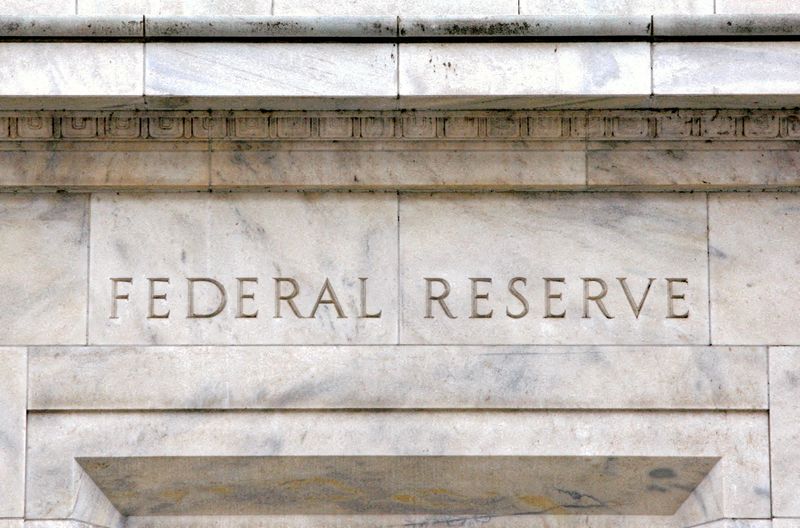
© Reuters. The U.S. Federal Reserve building is pictured in Washington, March 18, 2008. REUTERS/Jason Reed/file photo
(Reuters) – The labels “dove” and “hawk” have long been used by central bank watchers to describe the monetary policy leanings of policymakers, with a dove more focused on risks to the labor market and a hawk more focused on the threat of inflation.
The topsy-turvy economic environment of the coronavirus pandemic sidelined those differences, turning U.S. Federal Reserve officials at first universally dovish as they sought to provide massive accommodation to a cratering economy, and then, when inflation surged, into hawks who uniformly backed aggressive rate hikes. Now, divisions are more evident, and the choices – to raise rates again, skip for now but stay poised for more later, or take an extended pause – more varied.
All 12 regional Fed presidents discuss and debate monetary policy at Federal Open Market Committee meetings, held eight times a year, but only five cast votes at any given meeting, including the New York Fed president and four others who vote for one year at a time on a rotating schedule.
The following graphic offers a stab at how officials stack up on their outlook for Fed policy and how to balance their goals of stable prices and full employment. The designations are based on comments and published remarks; for more on the thinking that shaped these hawk-dove designations, click on the photos in the graphic.
Dove Dovish Centrist Hawkish Hawk
Austan John Jerome Christopher
Goolsbee, Williams, Powell, Fed Waller,
Chicago Fed New York Chair, Governor,
President, Fed permanent permanent
2023 voter: President, voter: “We voter: “If
“If conditions permanent are prepared inflation
keep going voter: “To to raise does not
like what me, the rates further continue to
we’ve seen the debate is if show
last couple of really appropriate, progress
months, our about: Do and intend to and there
arguments are we need to hold policy are no
going to do another at a suggestions
revolve around rate restrictive of a
how long increase? level until significant
should we keep Or not?” we are slowdown in
rates at the Aug. 2, confident economic
levels they 2023 that activity,
are rather inflation is then a
than how much moving second
higher should sustainably 25-basis-po
the rates go.” down toward int hike
Aug. 25, 2023 our should come
objective.” sooner
Aug. 25, 2023 rather than
later”
after the
July rate
hike. July
13, 2023
Patrick Lisa Cook, Philip Michelle
Harker, Governor, Jefferson, Bowman,
Philadelphia permanent Governor and Governor,
Fed President, voter: Vice Chair permanent
2023 voter: “If Designate, voter: “I
“Right now, I confirmed, permanent expect that
think that I will voter: “The additional
we’ve probably stay economy faces increases
done enough.” focused on multiple will likely
Aug. 24, 2023 inflation challenges, be needed
until our including to lower
job is inflation, inflation
done.” banking-secto to the
June 21, r stress, and (Federal
2023 geopolitical Open Market
instability. Committee’s
The Federal ) goal.”
Reserve must Aug. 7,
remain 2023
attentive to
them all.”
June 21, 2023
Raphael Susan Michael Barr, Loretta
Bostic, Collins, Vice Chair of Mester,
Atlanta Fed Boston Fed Supervision, Cleveland
President, President, permanent Fed
2024 voter: “I 2025 voter: “I’ll President,
feel policy is voter: “We just say for 2024 voter:
appropriately may be at, myself, I “Probably
restrictive.” or near, think we’re we need to
Aug. 31, 2023 the point close.” July bring rates
where 10, 2023 up another
monetary notch….It
policy can doesn’t
pause necessarily
raising have to be
interest September,
rates.” but I think
May 25, this year.”
2023 Aug. 26,
2023
Mary Daly, San Neel
Francisco Fed Kashkari,
President, Minneapolis
2024 voter: Fed
“Whether we President,
raise another 2023 voter:
time, or hold “I’m not
rates steady ready to say
for a longer that we’re
period — done.” Aug.
those things 15, 2023
are yet to be
determined.”
Aug. 10, 2023.
Lorie Logan,
Dallas Fed
President,
2023 voter:
“The
continuing
outlook for
above-target
inflation and
a
stronger-than
-expected
labor market
calls for
more-restrict
ive monetary
policy.” July
6, 2023
Thomas
Barkin,
Richmond Fed
President,
2024 voter:
“The
reacceleratio
n scenario
has come onto
the table in
a way that it
really wasn’t
three or four
months ago.”
Aug. 22, 2023
Note: Fed policymakers have been driving up borrowing costs since March 2022 to bring down high inflation, and in July they increased the target policy rate range to 5.25%-5.5%. Most policymakers as of June expected at least one more rate hike by year’s end. Longtime banker Jeff Schmid started as Kansas City Fed president on Aug. 21, but has made no public comments yet. He will be a voter in 2025. The St. Louis Fed has begun a search for a successor to James Bullard, who took a job in academia; the new chief will be a 2025 voter.








